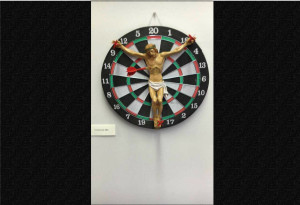 NEW BRUNSWICK, N.J. — Officials at Rutgers University have removed a depiction of Jesus crucified on a dartboard following complaints from those who found the display to be blasphemous and disrespectful.
NEW BRUNSWICK, N.J. — Officials at Rutgers University have removed a depiction of Jesus crucified on a dartboard following complaints from those who found the display to be blasphemous and disrespectful.
The display at issue was called “Vitruvian Man” and was part of an exhibition at the three-story university art library on Voorhees Mall. It featured a sculpture of Jesus affixed to a dartboard with darts on his hands and feet, as well as one in his side.
Last Wednesday, Rutgers student Natalie Caruso posted on on the Rutgers University Class of 2016 Facebook page that she had asked the university to remove the display.
“It is surprising that a state university would allow this,” she wrote. “I asked them to take it down because I found it disrespectful and they refused.”
The post sparked over 100 comments and shares, with some agreeing that the piece was problematic and others opining that it was simply art.
“Honestly I can see where you are upset, but at the same time it is art. It falls under freedom of speech,” one wrote. “It is allowed to be hung and the students who do not like it are allowed to protest and be angry. But you can’t be upset that they allowed it because freedom is speech is important.”
“Everyone saying ‘it’s just art’ sound ignorant. If you were truly religious you would be offended by the dartboard. Maybe you’re not religious and don’t care, but at least have some respect for the people that actually care about religion and respect for God,” another stated. “That’s like making a piece like this involving race and hanging it up in public; then would you say, ‘Its just art?'”
Some students said that perhaps the display wasn’t meant to be derogatory but was rather a depiction of the suffering of Christ.
“[A] real argument can also be: the artist is also religious, and is trying to describe how Jesus was treated during His life, and despite the ‘daggers/darts’ he experienced, such as being lied to, being disrespected, etc, He ‘died’ for us,” one wrote. “Art can be interpreted in so many ways. This may not even be a negative portrayal of Jesus.”
It is not known who created the piece nor the reasoning behind the depiction.
By the following day, after moving the display to another location, Rutgers announced that it had removed the piece altogether.
“The artwork in question was removed from the exhibit because it did not meet Rutgers University Libraries policy, which requires art exhibitions and their pieces to be based on university events, curricular offerings and topics of interest to the university community,” Jessica Pellien, director of communications at Rutgers University Libraries, told reporters.
“The process that the libraries use to determine how artwork is selected for inclusion in an exhibit takes into consideration freedom of expression as well as the criteria listed above. We have concluded that the policy and process the libraries use to select artwork for exhibitions was not followed,” she said.
Become a Christian News Network Supporter...


